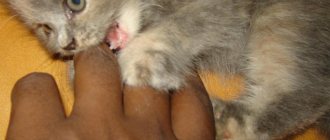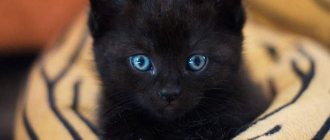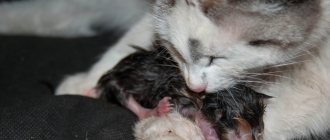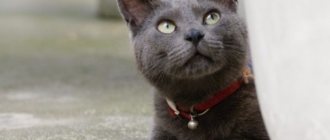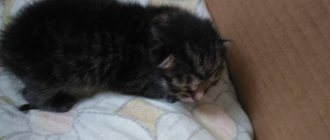When does puberty begin in cats?
For owners of females, the problem of mating their pet becomes relevant already at 6-7 months of their pet’s life: it is at this time that the cat begins her first heat. Of course, cats should not be mated at this moment, because the animal is still developing (and puberty and physical maturation are not the same thing!), but even then you need to think about future searches for a partner.
The situation is similar for owners of males: cats mature by 7-8 months, but if at this age castration is quite appropriate, then cats do not yet need mating: the animal is not yet ready for it!
If you don't know how old your pet is, the onset of puberty can be determined by certain changes in his behavior. In cats this manifests itself in:
- the appearance of more characteristic behavior (if previously the kitten was affectionate and gentle, now it may become a little aggressive),
- trying to mark territory,
- attempts to adapt various soft things for their sexual needs.
The signs of maturation in a cat are as follows:
- loud inviting meow,
- changes in gait (during heat, the cat raises its tail and arches its back),
- rolling on the floor
- changes in character - some cats become more aggressive, and some, on the contrary, become affectionate.
How does puberty manifest in cats?
The main sign of a female entering mating age is estrus. The cat becomes extremely affectionate, rubs against the owner’s legs, rolls on the floor, walks with its tail turned to the side, lifts its rump up - all these are symptoms of sexual heat. The female’s desire to meet with a cat is also manifested:
- An inviting cry. The female can call the cat day and night.
- Licking the genitals. This is how the cat removes secretions from them that appear during estrus. Her vulva itself swells and turns red.
- Trying to escape. During heat, cats often hang around the door, trying to seize the moment and rush outside to find a sexual partner.
In cats, sexual maturity manifests itself in a similar way. Signs of sexual heat in males:
- The animal begins to scream loudly. By evening, the love call can intensify and turn into wild screams.
- The male becomes aggressive and actively marks the territory. He does this instinctively so that his scent will attract a female. Unable to mount a representative of the opposite sex, the cat bites and scratches the furniture in the house.
- The pet is trying to escape . Some animals leave the apartment through the window. Finding them later can be difficult.
When should you think about mating?
As a rule, the first mating of cats should occur at least after the animal is one and a half years old. A female, for example, can be “introduced” to a partner only when she has gone through 2-3 heats, but the ideal age of a cat for mating is one and a half to two years. By this time, the animal will have time to fully develop, and you will have time to give it all the necessary vaccinations. Remember two rules:
- mating of cats should not be carried out during the first heat, even if it comes late (this can end very unfavorably for the animal!),
- two weeks before mating, the animal should not be given any vaccinations.
Also, you should not delay the mating itself: this can lead to various anomalies (exhaustion of the animal, disruption of the estrus cycle, or even the development of polycystic disease), so it is better to take care of selecting a partner for your pet, regardless of whether you want to do it!
Mating a cat: rules
First of all, you should remember that you should not abuse drugs that suppress or stop estrus. Most often, their use for their intended purpose is not effective, but can lead to hormonal imbalance in the animal’s body or cause serious illness. Therefore, it is best to immediately realize that you will need mating between a cat and a cat, and you need to prepare for it according to special rules.
So, cat owners should remember that:
- A suitable partner for your pet must be found in advance (those involved in breeding will need to look for him in the appropriate club, and those who need regular mating can do this through advertisements or at cat shows; if a suitable partner is not found immediately , consult cat clubs where they can help you find a match for your cat);
- Before mating, the cat must be checked for various diseases - infectious, viral, invasive, fungal, etc. (the cat should be checked in the same way!);
- Two weeks before mating, the cat should undergo preventive deworming - getting rid of worms, if any;
- Before the mating process itself, the cat (and male cat!) needs to have its claws trimmed so that the animals cannot injure each other;
- It should be remembered that preparing a cat for mating does not involve washing it, because this can destroy its natural scent that is attractive to the cat.
For cat owners, the rules are:
- They are the ones who must control the mating process and help the animals if necessary;
- The cat owner will have to ensure that two “untied” animals do not mate - this can cause mental and physical trauma to them;
- The owner of the cat accepts the cat on his territory, so he must provide her with the opportunity to independently get out of the carrier and get to know the cat, and, if necessary, take refuge in a special enclosure where a scared or aggressive cat can “sit out” for a while and get used to the changes in her life.
Preparation for mating during breeding
Owners of breeding animals should also remember special rules: before breeding a cat, they must agree on the terms of payment (if necessary), as well as the duration of the female’s stay in the cat’s owner’s house. It is advisable to do this in writing, and in this case, a cat mating agreement can help, which professional breeders can help draw up.
In addition, serious breeders are sure to collect as much information as possible about the origin of the cat chosen to pair with their pet. This implies:
- identification of possible genetic defects in the animal (bad bite, poor coat, uncharacteristic colors, etc.),
- examination of kittens from other litters of the cat (if the cat has already had offspring),
- checking whether the cat is prepotent - that is, whether he can pass on good qualities and characteristics to his offspring.
If you find any deviations that suit the owners of the cat, you should definitely include all the data about them in the cat mating agreement. Only this will save their owners from subsequent proceedings.
How is the mating done?
It is best to schedule a “meeting” between male and female cats on the 3rd-5th day of the cat’s estrus. At this time, mating will be most effective, although in some breeds of cats ovulation may not occur earlier than the 9th day. As a rule, mating takes place on the territory of the cat, where all conditions for mating cats must be provided. However, the owner of the female will also need to prepare by taking with him:
- pet toilet,
- food and a bowl from which she eats,
- a carrier that the cat is accustomed to - if necessary, the animal can hide in it and rest.
You can recognize a cat’s readiness for mating by its behavior: it begins to flirt with the cat itself, initiating sexual arousal in him. At the same time, when the cat tries to approach, the cat begins to show dissatisfaction, and the male has to recoil and pretend that his partner is not at all interested in him. This should be repeated several times, but sooner or later the cat will lose vigilance, and then the cat will sit down. If this is the first mating of a cat, and the animal is nervous, its owner should calm it down if possible and make sure that the cat does not cause any injury to the cat.
Mating usually lasts only half a minute and is accompanied by expressive purring from the cat and loud cries from the cat. At this moment, the cat is provoked to release the egg from the ovaries, and then fertilization occurs within 24 hours after mating. Such mating can take place 5-8 times, and this “cycle” usually ends when one of the partners gets tired of it. It should be remembered that one covering may not be enough for a successful mating, and in this case the cat will need to spend 1-2 days with the cat.
You can again recognize the completion of mating by the behavior of the animals:
- After mating, the cat turns over on its back and rolls around,
- After mating, the cat moves away and begins to lick itself.
When does that very moment of mating come?
Experts believe that a cat should reach 1-1.5 years of age. 18 months is the deadline for the first mating. All breeders recommend mating cats after two heats. This is the most suitable period for mating. Males are ready for mating earlier - at 8-10 months (some breeds, for example, Scots at 1.3-1.6 years). Differences in age among males are due to breed. Unlike cats, cats are eager to mate all year round, especially when March comes.
Cats need to select an experienced female for the first mating. Although in practice, even a couple of untied feline representatives will cope with the task. The reproductive instinct in animals is incredibly strong, it is almost a basic need.
After mating, the male needs time to rest and recuperate. You also need to feed your cat nutritious and balanced food. The health of the pet during the mating period must be carefully monitored: be observed by a veterinarian, check for infections and viruses, carry out deworming measures and vaccinations, get rid of ticks and fleas. Prevention measures are also important. The doctor issues a certificate about the pet’s condition; this document will give a guarantee to the female and increase the reputation of the cat’s owner.
Important! Before mating, owners of pedigree animals show documents confirming the origin of the male cat. There are owners who enter into contracts for the mating of animals and the distribution of “profits,” that is, kittens.
During the period of acquaintance with the “groom” and mating, the cat must be in heat, otherwise there will be no mating. If possible, both cats' claws are trimmed to prevent injury.
Complications that mating cats may have: rules of conduct for owners
Unfortunately, just like humans, cats and kittens can also experience incompatibility. Sometimes its manifestations are easily overcome, but there are times when this can lead to additional problems, so you need to initially be prepared for this and know how to help animals if necessary.
Complication No. 1: animals do not match each other in size (the cat is larger than the cat)
In this case, the cat, grasping the female's withers with his teeth, cannot impregnate the cat, because the back of his body rests on her back. In such a situation, the owner must help the cat by grabbing the withers with his hands and giving the male the opportunity to grab the skin below the withers.
Another case is when during coitus the female falls over on her side
The owner will have to hold the animal in a suitable position (there are situations when cats are able to solve this problem without outside intervention).
The female is not given - a difficult situation, since the lady decides with whom she will have sexual intercourse. I have to take her home. As a last resort, you can use a probe inserted into the vagina. With its help, ovulation is provoked, and the cat will surrender into the clutches of an unloved man. Also, some breeders lock up two purrs of different sexes and believe in contact between them.
A situation where a female suddenly stops estrus with all the accompanying signs. This happens due to stress. We must wait until the cat gets used to it and gets used to it, everything will be restored. Probably, the female should be left to stay with the cat owners so that the animals can get used to it and make friends.
There is no heat - this happens if the pet’s behavior is mistaken for sexual heat. But the gentleman will never let you down. Only in the case of absolute indifference and complete lack of attention to the cat can we talk about the absence of intercourse between animals.
Should you give your cat birth control?
This is a very important issue that requires separate consideration. Many cat owners consider such medications to be an alternative to sterilizing their animal, but this is not true: contraceptives cause irreparable harm to your pet! In particular, they can cause:
- the appearance of neoplasms in the uterus,
- the occurrence of ovarian cysts,
- hormonal imbalances.
In this case, pathologies of the reproductive system can occur only after a few years, when the cat is already elderly, and you will have to either decide on a risky operation or euthanize the animal. Therefore, if you do not want to endure regular heat and the cat’s behavior after mating, it is better to immediately sterilize your pet, which will not only save you from the hassle of organizing mating, but will also protect your cat from serious and dangerous diseases.
Join us in social networks:
Just yesterday the kitten was cute, docile, playful, but today his behavior has changed dramatically. The animal shows aggression, it is attracted by the street, the thirst for communication with its fellow tribesmen. This is how the readiness to procreate is manifested. What awaits kitten owners at this time and how to react correctly to the process of growing up of the pet?
How does a cat feel when she is kissed?
When cats kiss
, do they understand that this is a sign of tenderness, or do they just tolerate it?
When we them
, they usually understand that this is a sign of tenderness.
They experience pleasant sensations when we gently touch them
, especially in the face and neck area.
Interesting materials:
How to write the second one correctly? How to properly stretch a stretch ceiling? How to wear a snood around your neck correctly? How to update your smartphone correctly? How to properly treat a wound with Streptocide? How to properly clean a CD? How to renounce Belarusian citizenship correctly? How to properly adjust sectional doors? How to transfer leaves correctly? How to properly re-register a car?
Puberty in cats: when it occurs, signs
The moment at which kittens begin puberty depends on various factors. There are early individuals who express a desire to rejoice already at 4-6 months of age, others mature late and begin to show interest in the opposite sex at about a year. The average age for the onset of the “X hour” is considered to be 7-9 months of age.
Puberty in cats
Before the start of the first heat, the young cat begins to show anxiety, becomes affectionate to the point of intrusiveness or, on the contrary, aggressive, this lasts from 2 to 4 days. As the situation develops, she often urinates and actively licks the swollen genitals. Attention is focused on finding ways to freedom.
Open windows and doors attract the animal. Her appetite disappears, she begins to purr, roll on the floor, rub herself against furniture and people’s legs. Clear or bloody mucus is released from the genital opening.
In the active phase, the cat meows day and night with a special calling timbre. When touched on the sacrum, it assumes a mating position and moves its tail to one side. The readiness stage occurs 4-6 days from the start of estrus. Then the excitement decreases, and when mating occurs, the formation of embryos begins.
After 12 days from the first signs, the thirst for “marriage” goes away. Cats come into heat twice a year. If you notice that periods of lust occur more often, you need to show her to the veterinarian; increased libido occurs with cysts on the ovaries and other internal pathologies.
Puberty in cats
One of the signs of approaching maturity are marks. The cat leaves them everywhere, trying to attract potential “brides” to his territory. The pungent smell literally eats into furniture and doors. The animal becomes nervous, irritable, shows aggression, does not go to hand, and loses interest in games and food.
May try to bite the owners, rushes to their feet and tries to scratch. The pet is looking for ways to escape from home, singing mating songs all day long. It makes no sense to suppress changes in the behavior of a male who wants a cat using educational measures. Instinct takes over. Cats are in a state of heat all year round, regardless of the season.
How to prepare an animal before mating
You should not wash him or her with shampoo - this will remove the natural odor that affects the sexuality of cats. For the first mating of a cat, the male must be untied, this reduces the likelihood of psychological trauma in the pet.
Among professional breeders, the male's home is considered a suitable place for mating. A cat is brought in there and an acquaintance takes place. The female either lets the cat in or drives her away, repeating these techniques. Then, when anger is replaced by mercy, quick sexual intercourse is performed (the total number in an hour sometimes reaches 8 times).
The following signs will help you find out that the action is over (and the owners are not required and not even recommended to be in the same room during mating):
- If after mating the female lies on her back and rolls around on the floor.
- The male has moved away and is licking his genitals with indifference.
However, the cat is not taken from the groom’s house; the entire mating cycle is completed after 5 days, sometimes in a couple of days if the female gets to know the male quickly and gets to know him closely. Therefore, while the pet is in the guest room, they put a tray, her food and water bowls in her luggage, and leave a carrier with her scent so that the cat can sleep and rest there. When the female is ready for intercourse again, she will begin to flirt with the cat.
Important! It is the responsibility of the owners of the female to inform the opposite party about the results of mating after three weeks.
There are also non-standard cases that require solutions. This is due to incompatibilities in the cat family. For example, size discrepancy, the male is smaller than the female. In such a situation, the cat’s genital organ, resting against the cat’s back, is not able to fertilize her. This means that the male has to be guided.
What determines the speed of puberty in cats and cats?
The beginning of puberty in cats depends on the breed: representatives of sphinxes, Thais, Siamese, orientals, and other species belonging to the oriental type enter adulthood earlier than their counterparts. Animals of “graceful” build are also prone to early awakening of libido, even if they belong to a mongrel breed.
Kittens born in winter may already feel the call of nature in summer or late spring. Early puberty is observed in nurseries or when owners keep several individuals, especially if some of them are already adults. Pheromones of sexually mature relatives contribute to the rapid maturation of young animals.
Pets that receive a sufficient amount of high-quality nutrition develop faster than their street peers living from hand to mouth. Don't write off genetic predisposition.
What is puberty in cats and kittens?
Puberty in young pets refers to the body’s readiness to conceive. An adult cat is considered to be one that is capable of fertilizing a female. A female is considered mature at the moment when she can not only become pregnant, but also bear and give birth to healthy young.
Many are sure that this period begins in females already from the first heat. However, in reality, neither females nor males can give birth to full-fledged offspring until their body is fully formed.
The time at which an animal reaches puberty depends on a number of factors. The process is influenced by:
- Breed. Representatives of Asian species mature a little earlier than their northern counterparts.
- Time of birth. Summer kittens take longer to mature than babies born in late winter or early spring.
- Habitat. Residents of city apartments, surrounded by the attention of their owners, remain in childhood for a couple of months longer than street kittens.
- Dimensions of the animal. The larger the individual, the slower it matures. Excess weight often causes a slowdown in the maturation of the reproductive organs.
- Length of daylight. This factor affects wild and street animals.
- Living conditions. If an animal experiences a deficiency of essential nutrients or even starves, its development slows down or stops, since the body uses resources sparingly and spends them on maintaining vital functions - breathing, blood circulation. Childbirth is not one of them.
Optimal age for first mating
If the animal is of breeding value, and the owners want to produce promising offspring, then it is necessary to take care in advance of finding a suitable pair. If the birth of kittens is not part of the owners’ plans, it is worth castration (sterilization for females) of the pet, saving yourself and it from unnecessary problems.
The first mating should occur no earlier than the purr reaches one year of age. The cat begins to mate from the second or third heat. The fact is that the body’s first signal of puberty occurs before full physical formation is complete. Early pregnancy is fraught with subsequent health problems, difficult childbirth, and death of the offspring.
You can survive the onset of puberty using special medications. Cat marks are washed with water and vinegar, which removes the smell of secretions, or sprinkled with ready-made compounds sold in pet stores and veterinary pharmacies.
There are tablets and drops that allow you to delay estrus, for example, if you plan to participate in an exhibition, but you should not abuse hormonal drugs.
This is quite understandable, that’s why I also want to take the second one. In this situation, the cat's owner can help him. In each specific case, different measures are taken, so we will consider the most typical situations. What do cat owners need to know in order to, if possible, avoid trouble, and, if problems arise, be able to solve them? In some cases it is easily overcome, in others it leads to serious problems.
A cat's readiness can be determined by its behavior.
This is done to avoid possible claims from one side or the other.
If there are shortcomings, but they suit both owners, this point must be reflected in the contract.
When choosing a partner for his pet, the owner studies a lot of information in order to get the highest quality offspring.
If you are a member of the club, there should be no difficulties.
How to do it?
A young cat can be mated with a male cat when the cat reaches puberty and is strong enough to become pregnant and give birth to kittens without risking her health. Situation No. 3. The cat doesn't want to let the cat near. In this case, it is difficult to do without a specialist. Situation No. 2. The cat doesn't want to stand. It usually lasts half a minute. At the first mating, the cat may be nervous, so the owner should be nearby in order to calm the animal. This game will continue until the cat loses its vigilance.
If necessary, she will be able to take refuge and rest during her stay on foreign territory.
You should not try to breed a scared cat right away. Let her sit in a secluded place for a while and get used to the new environment.
If a cat behaves aggressively, it can be temporarily isolated in a special enclosure.
A cat can constantly (once a month on average) impregnate a cat; a cat cannot give birth more than 2 times a year. Do you understand what you are dooming your animals to? If a cat falls over on its side during mating, it must be supported. Mating can occur up to 8 times, until the cat or female cat gets bored. At the same time, the cat screams, and the cat purrs expressively. Within 24 hours after mating, fertilization occurs.
Mating itself does not take much time.
If you are going to breed a cat, you should not abuse drugs that suppress the desire for the opposite sex or stop estrus.
Restrictions on the timing of mating for cats are due to the fact that pregnancy that occurs after the first (even after late) estrus in most cases ends unfavorably.
In this case, pathologies of the reproductive system can occur only after a few years, when the cat is already elderly, and you will have to either decide on a risky operation or euthanize the animal. Contraceptives do not replace sterilization, firstly. Drawing analogies between contraceptives and sterilization is fundamentally wrong. Should I give my cat contraception?
When is the best time to neuter an animal not intended for breeding?
It is recommended to castrate an animal that is not of breeding value. Otherwise, the owners will have to listen to the wild cries of the pet almost every month. Empty heats are also harmful to the health of the cat itself: this leads to various pathologies of the reproductive system. To protect the animal from needless suffering and prolong its life, it is recommended to castrate it.
Castration is an operation to remove reproductive organs. The female's uterus and ovaries are removed, while the male's testicles are removed. As a result, animals not only lose their ability to reproduce, they also stop producing hormones that provoke sexual estrus. The operation has a number of advantages:
- The male stops marking the territory and damaging the furniture, the female stops asking for the cat. This makes their maintenance much easier.
- Animals do not suffer due to the inability to satisfy sexual desire. The life of castrated cats and female cats is calm and measured. They make ideal pets.
- There is no need to regularly give your pet medications to eliminate characteristic manifestations. According to veterinarians, their constant use causes hormonal disorders and cancer of the reproductive organs.
The operation can be carried out throughout the life of the animal, but it is better to do it immediately after the onset of sexual maturity - i.e. at 6-9 months. Some people think that it is necessary to let the cat give birth at least once, but this is not true. However, it is also possible to castrate a cat that has given birth. It is not worth castrating animals before puberty - they may exhibit deviations in physiological maturation.
Source
Reproductive age of a cat
Most cats can become pregnant and give birth before the age of one year. Most often, females reach sexual maturity at the age of six to eight months. But sometimes this can happen much earlier - at four months. However, veterinarians consider such a young age unfavorable for the first pregnancy: it is better if it occurs after a year.
From the very first heat, a healthy cat retains the ability to become pregnant and give birth almost until death. Animals do not go through menopause. True, everything depends on the health, living conditions, and general condition of a particular individual. The safest period for pregnancy is from two to five years. And the frequency of births is no more than once a year or at least after one heat.
The estrus itself (scientifically called estrus) occurs without visible symptoms. That is, you will not see “traces” of this condition - bloody discharge. But behavior changes noticeably. The cat becomes restless, obsessively affectionate, fills the house with inviting cries, and tries to escape outside the house. The estrus period lasts an average of a week. However, its duration varies from person to person. Periodicity also does not have a fixed frequency. Some flow every month, while others only flow twice a year. The classic frequency is once every three months, that is, every season. However, for nulliparous cats or cats that have not yet bred, this is not relevant.
Experienced male and female breeders know general recommendations for successful breeding of animals.
A diet that includes high-quality natural products is important. Meat and fish, vegetables, as well as holistic or high-end food are suitable.
Examinations at the veterinary clinic should be regular for both male and female cats. In the absence of visible signs of disease, the animal may have a congenital or chronic disease. Such a gene pool is dangerous for future offspring due to its possible acquisition. Twice a year is the norm for medical examinations for your pet.
Frequent mating is actually harmful, even despite the constant readiness for coitus from a sexually mature male. Constant mating reduces the quality of sperm, which will certainly affect the future litter. The break between knots should be at least a week.
Mating can be stressful for a cat, but you shouldn’t stuff your pet with tranquilizers. There is a possibility of disruption of estrus, and therefore the entire process. Although the trip turns out to be a shock for the female, we must try to calm her down without sedatives, for example, by taking with her her favorite things with a familiar home smell. This will give the cat confidence, and therefore the possibility of mating.
Everything that is needed and how the first mating of a cat with a cat occurs should be known to the responsible owners (apparently, these are the “parents” of the male). Their duty is to comfortably help pets mate. You cannot quickly or forcefully bring animals together; they will decide for themselves whether they are ready for intercourse or not. Successful mating can occur the next day.
First signs of pregnancy
Let’s immediately make a reservation that in the first three weeks you will not be able to get a definite answer to the question about your pet’s pregnancy. Even in a veterinary clinic they won’t help you with anything: an ultrasound won’t show it, the doctor won’t probe it. However, if your pussy walks on its own, then the period of the next heat ended happily (for her) or, rather, fruitfully. There’s no point in guessing whether there are any signs or not, and in nine weeks your house will be filled with the sound of newborn kittens squeaking.
And it often happens that the owners are simply not sure that the act of love has taken place. This especially often applies to those moments when the cat is specially taken to the cat for these purposes. However, experienced breeders have identified a number of signs:
- Immediately after visiting the cat, the cat returned home resumes its love chants (asks to return), this indicates that the wedding night has taken place, one can hope for kittens.
- If the calling cries resumed a week after returning from the groom, then nothing worked, the cat understands that she did not become pregnant and requires a second visit.
- The estrus quickly stopped after communicating with the partner - offspring can be expected.
- After the love rendezvous, she stopped giving any signs of her desire to become a mommy - most likely, the goal was achieved.
In fact, this behavior may not mean anything, but often these signs turn out to be true.
One more observation. If the owner resists adding to the cat family, then after the first mating your kitty will become pregnant. If, on the contrary, you want to see your cat pregnant, then your dreams will remain dreams for a very long time.
Clear signs of pregnancy
Pregnancy can be determined three weeks after conception. The very first, most obvious is a change in the color and size of the nipples. They swell slightly and turn pink. This happens towards the end of the first trimester of pregnancy, when the embryos already reach a size of one or two centimeters.
During this same period, the veterinarian will be able to palpate and determine not only the presence of kittens, but even their number. By the third week of pregnancy, the belly also increases slightly, but it is difficult to notice. The hormonal levels are already noticeably changing, so the pussy may suffer from morning sickness.
A sharp change in behavior also indicates an interesting situation for your pet. And an ultrasound performed at this particular time will certainly help you find out.
Only after half of the pregnancy do signs of an interesting position become visible to the naked eye. From the fourth week, kittens begin to develop intensively, so the belly of a pregnant cat grows quickly.
You can already feel the movement of the kittens with your palm, and if there are a lot of them, you can see it. True, in cats that bear only one or two cubs, the belly does not increase much.
Pregnancy affects the behavior of the animal. Many cats become calmer and more indifferent to current events. They sleep for a long time (longer than usual) and persistently demand attention and affection. Pregnant cats become more tender not only towards people, but also towards other animals living in the same house with them. Towards the end of pregnancy, the nipples begin to droop, the belly becomes noticeably larger, and the cat itself tries to find a place for the upcoming birth.
Some pets do not change their constitution throughout pregnancy. And in some long-haired breeds it is difficult to see not only changes in color and size of the nipples, but also the nipples themselves are difficult to find. Therefore, sometimes it can be difficult to distinguish a pregnant kitty from a non-pregnant one. Here, only ultrasound examination will help to dot all the i’s.
On a note
- Human pregnancy tests do not work on animals.
- You can reliably find out about pregnancy or its absence only with the help of an ultrasound examination.
- False pregnancy in cats is very rare, and in veterinary medicine it is considered a neuropsychiatric disease.
Course of pregnancy
The gestation period is on average two months. Most animals experience this period relatively calmly. In the first month, no visible changes in appearance or behavior are observed.
By the end of the term, the expectant mother simply swells before her eyes. The abdomen becomes rounded, large and tight, and fetal movement can be seen. If by this moment the cat’s belly does not increase significantly, she is simply bearing a small number of kittens. But if you put your hand on it, you can feel the kittens moving.
About a week before giving birth, the belly of a pregnant cat takes on a pear shape, and the nipples noticeably droop and colostrum appears in them. If you lightly squeeze the nipples with your fingers at this time, a translucent drop of white or yellowish color will appear on them.
Even if there are no external signs of an interesting situation, then by the end of pregnancy the cat will definitely begin to show anxiety and look for a place for the upcoming birth. This is also a clear sign of pregnancy, and the behavior itself is called nesting.
It shows the natural instinct of a cat. About two weeks before giving birth, she begins to look for a place for a “nest” - a comfortable, calm, warm place where she will have to lamb and spend the first weeks of their lives with the kittens. The main criterion for selecting a nest site is safety. Therefore, it is possible that your pet will begin to persistently break into closets, try to arrange such a place on bookshelves and in other places that are difficult for you to reach.
This is a good time to introduce your cat to the birthing box that has been prepared for her, and also to reassure her that this box is best suited for her nest. If you don’t do this, she will independently arrange a “maternity ward” for herself, and it is possible that in your bed.
Possible pathologies
Even a healthy cat can have pathologies. During this period, exacerbation of chronic diseases, infections, and hormonal disorders is possible. Even if a pet is in good health, it is not immune from such pathologies as:
- Primary or secondary ectopic pregnancy. Without treatment, the prognosis is extremely unfavorable, and everything can end in the death of the animal. However, a caesarean section or induced abortion will save the cat's life.
- Abortion (spontaneous) or miscarriage. Firstly, it is impossible to stop this process, and secondly, it does not pass without consequences. Therefore, you cannot do without the participation of a specialist.
- Post-term pregnancy can cause inflammation of the uterus and death of the fetus. The veterinary clinic will induce labor or perform a caesarean section.
- Torsion of the uterus occurs when a cat falls or makes sudden movements. If your pet is excessively active during this period, be vigilant. This pathology is treated only by cesarean section.
Caring for a pregnant cat
During pregnancy, a cat does not need special care: after all, pregnancy is not a disease, but a natural state. Therefore, there is no need to limit her mobility. Try not to overfeed her. A sedentary lifestyle can provoke obesity in an animal, even if not during pregnancy, then after childbirth. An excessively rich diet also contributes to this. If in its normal state a normal healthy cat is able to control its appetite, then a pregnant cat often loses this control and can eat too much. It is necessary to tame excessive jumping ability only in the last stages of pregnancy.
In the first month, the diet should be the same in volume and composition. However, veterinarians advise increasing the amount of vitamin-rich food. If at this time the cat shows interest in fresh vegetables and fruits, then try giving her carrots, zucchini, apples, and pumpkin. Although such changes in taste preferences are rarely observed. If your pet is accustomed to ready-made food, then switch her to kitten food, which is also suitable for pregnant cats. It is not forbidden to give vitamin supplements, but only after consultation with a veterinarian.
During the second trimester of pregnancy, increase the amount you eat by one and a half times. And during this period, she needs protein-rich foods: cottage cheese, sour milk, chicken eggs, beef. Just food should not be fatty, much less fried or spicy. Never feed your cat what you eat yourself: smoked and spicy foods are contraindicated.
Proper care means systematic monitoring by a veterinarian. Such visits are preventive and advisory in nature. However, at the very beginning of pregnancy, the cat needs to be examined by a veterinarian. This will save her from possible complications, and you from unnecessary hassle and expenses for treatment. Shortly before giving birth, it is also necessary to undergo another examination.
How to prevent pregnancy
No matter how beloved your cat is, if you do not want to get offspring from her, you need to take preventive measures. The most radical way to rid her of the prospect of pregnancy is sterilization. Today this procedure is no longer very expensive, and it is performed in almost all veterinary clinics.
Sterilization can be surgical, radiation, or medication. The safest in terms of consequences is surgical. Surgical sterilization is carried out using several methods:
- The fallopian tubes are pulled. In this case, the cat only loses the ability to conceive, but her estrus continues (as well as calling calls).
- The uterus is removed, but the ovaries are retained. The effect of such an operation is the same as in the first case.
- The ovaries are removed. The hormonal background of the animal changes completely, estrus stops, and there is no risk of false pregnancy.
- The uterus is removed along with the ovaries. This method is already called castration.
The most favorable sterilization method for an animal is spaying, but its use is only possible for young (up to a year) cats that have never given birth. If she is already more than a year old, if she has given birth to kittens at least once, then the animal will have to be castrated. But the first two methods are almost never practiced, as they do not have very good consequences for physical and mental health. The veterinarian must decide which method to choose.
There are usually no side effects from a well-done operation. But spayed or neutered animals are prone to obesity. In all other respects, she remains the same, maintaining playfulness, general activity, and all instincts (except sexual).
Sterilization is the most humane and effective way to prevent pregnancy in cats. But if you are sorry to put your pet under a surgical knife, then you can stop at special injections - injections of hormonal drugs. Another (most common) way to prevent cat pregnancy is oral contraceptives. But this method does not always work and also has a bad effect on the physical health of the animal.
This article answers the most frequently asked questions about cat breeding.
At what age do cats go into heat?
Cats usually reach sexual maturity when they weigh about 4.5 – 7.0 pounds
(2.3 – 3.2 kg) or at five to nine months of age. However, even
four month old kittens may go into heat and become pregnant! Also,
Domestic short-haired and long-haired cats can reach puberty
maturity earlier than purebred cats, and stray cats can reach
maturity earlier than domestic ones.
How long does heat last?
The duration of estrus (heat) is different for each cat. On average, estrus lasts
seven days, but sometimes can reach 21 days. If the cat does not mate and
becomes pregnant, then estrus may begin again, with breaks between estruss in
At what age can a cat become pregnant?
A cat can become pregnant as soon as it reaches sexual maturity (approx.
At what times of the year can a cat become pregnant?
Cats can become pregnant at any time of the year, especially in average climates, but
Most often, mating and pregnancy occur in the spring.
How long does pregnancy last in cats?
56 – 71 days. The average duration of pregnancy is 67 days.
How many times a year can a cat kitten?
Up to five times a year!
On average, how many kittens can a cat give birth to at one time?
On average, a stray cat gives birth to three kittens, but sometimes six
Can a cat get pregnant while nursing kittens?
Certainly! Typically, cats go into heat 1-2 months after giving birth, and during this
time they can get pregnant again. Some cats may go into heat
a week after giving birth, which can lead to pregnancy.
Is it possible to sterilize cats while they are nursing kittens?
Yes. A cat spayed while nursing kittens will continue to
produce enough milk for their kittens. Some veterinarians
prefer to wait until the cat stops feeding the kittens before
surgery because breast development during breastfeeding may
If the cat can be kept indoors away from cats, then you can
wait to sterilize until she stops feeding kittens
(then you can spay or neuter the whole family). If the cat can't
is away from the cats during feeding, then you need to sterilize her
As soon as possible. Return your cat to kittens as soon as possible after surgery.
If a nursing cat is wild and needs to be caught, then it is advisable to catch and
kittens (if possible), or wait until the kittens are at least
six weeks, in order not to leave the kittens without their mother for a long time.
At what age do non-sterilized cats stop giving birth?
Unlike humans, cats do not go through menopause. Although fertility is gradual
decline over time, there is no conventional age after which
the cat may stop getting pregnant.
Can cats from the same litter mate and create kittens?__
Yes. It is for this reason that cats and female cats from the same litter live together
must be spayed and neutered for up to four months.
Is it okay to let your cat give birth once before?
No! This will not bring any benefit to the animal. Spay your cat before the first
litter, or better yet, before the first heat is easier and safer.
Recent experimental results have shown that sterilizing a cat up to six
months significantly reduces the risk of breast cancer.
PS. If you have any questions, please call 24 hours a day at 540-03-03, 565-84-98 and our doctor on duty will give you a free consultation.
